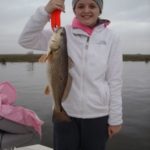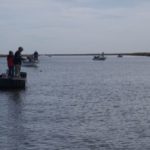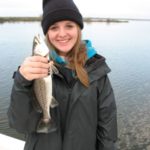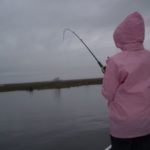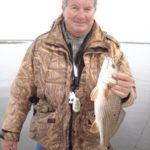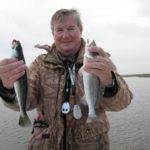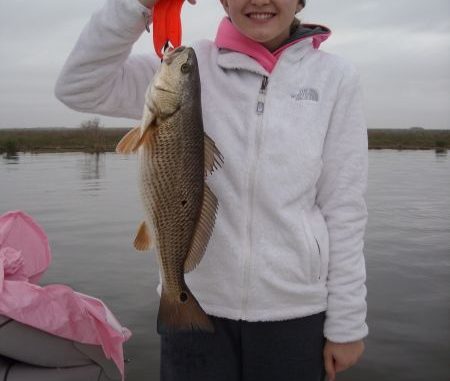
Looking for a no-fail spot to load the boat with reds, specks and even bass this month? Head to Delacroix’s Oak River, where even a novice can catch fish.
In the days before levees channeled the Big Muddy, Oak River was a natural funnel for the mighty Mississippi. For centuries it was a conduit for fresh, muddy water, and silt and sediment gradually built up significant ridges that line Oak River to this day.
As its name suggests, the banks of the water way were thickly populated by wild oaks, and a variety of brush and other vegetation that thrived in the continual flow of nutrient-laden water. For mile after meandering mile, so thick and indicative of the waterway were the trees that someone long ago labeled it River Aux Chenes — Our River of the Oaks.
Of course, the levee system changed everything, closing off Oak River from its original freshwater source and relegating it to its present function as a funnel for tidal waters from the Gulf of Mexico.
Fast forward to the present, and the great trees are all gone, with just a few scrub oaks tenaciously clinging to life even as their roots marinate in high salinity waters.
But what was bad for the trees has been good for fish and those who seek them.
Oak River is one of the bright spots in an otherwise bleak month, consistently producing fish for hardy anglers willing to brave February weather.
And here’s a bonus: You don’t have to be an expert to catch those fish.
I had a trip all arranged with Capt. Ron “Ahab” Broadus, and Capt. Mike Wittich. They’d planned to have their partner-in-crime, Ryan Schaffino, join us as deckhand, and the four of us would fish Oak River for some cold weather trout.
But as author John Steinbeck noted long ago, “The best-laid plans of mice and men often go awry.” Things often just don’t go as planned.
Ahab got sick, sick enough to have to be admitted to the hospital. Ryan also had to cancel.
Then the weather forecast took a turn from overcast and gray to cold and rain, and I was ready to pull the plug when Wittich called.
“Let’s go!” he said. “We can still sneak a trip in early before the winds blow and the rains arrive, and you can invite somebody to come along with us.”
So I invited two somebodies — my 16-year-old twin grand-daughters Shelbey and Sydney Evans, who are always eager to jump on the boat and fish with Pawpaw.
Thick fog delayed our departure for about an hour, but once Wittich could see far enough ahead to safely run the boat, we headed for Oak River.
The twins, draped in jackets topped with rain gear, huddled behind the leaning post against the morning wet and cold. Thankfully, the run across Little Lake and through Grand Lake is mercifully short, and before long we idled up to a stretch of water from which Wittich snatched a bunch of fish the day before.
“Oak River stretches for miles, probably 25 miles or more, but about half of it — up past Spanish Lake — is fresh water, and a lot is silted in.
The most-fishable part extends for about 13 miles, from Orange Bayou to the mouth at Oak River Bay.
I concentrate on about half that distance: from Orange Bayou to the Pencil Canal. The most-congested area is in between the Pencil Canal and the Spider Canal, with most anglers focusing on the openings to the various bays.
“That is a very productive area, but I avoid it basically because of the traffic,” Wittich said.
There is no denying that Oak River is a magnet, attracting fish and fishermen from long distances because it offers what fish are looking for, especially in the colder months of the year.
It has deep water, where fish huddle during colder conditions, and the banks are steep ledges leading to shallow flats where bait swarms when the sun gets up.
Those ledges, where depth falls from shallow to deeper, are especially attractive to predatory species.
“You know, the trout and redfish will get along those ledges when it gets warmer, and they’ll spread out into the nearby shallow bays because shallow water warms up faster,” Wittich said. “On warmer days you can pop on a cork and fish them shallow, in 2 to 4 feet of water. Don’t be as aggressive in winter with popping your cork, but don’t just let it sit, either.”
Wittich likes several different baits in the colder season, and he said other anglers have success with a variety of baits.
But he tends to stay with a few favorites.
“I like the Bass Assassin curly tail baits in white, opening night or chartreuse, and I like H&H beetles or cocohoes in purple/chartreuse or black/chartreuse,” Wittich explained. “I’ll fish them about 2 ½ to 3 feet under a hard-plastic cork on milder days, and I’ll usually tight-line double rigs on colder days, using a 3/8(-ounce) jig on the bottom, and a ¼(-ounce) jig on the top.”
Wittich likes the curly tail baits because they always produce motion without having to move the bait.
“On colder days those fish will be snug to the bottom or near to it, along the ledges. They feed if they don’t have to expend a lot of effort,” he said. “If you fish fast like in spring and summer you won’t catch much, if anything. But that curl-tail will flutter like a fish tail while the bait is virtually standing still, making it a easy target.
“If you’re having trouble catching fish on colder days, switch to something with a curly tail and see if it doesn’t make a difference.”
Getting in position to take advantage of the masses of fish prowling the depths.
“If you fish Oak River, you’ll see boats anchored all kinds of ways: in the middle, some off to the side, some even try to drift if there’s room,” Wittich said. “There’s no single way to succeed out here because when the fish are biting everybody is catching.
“If you anchor in the middle, you can fish deep and you can fish the ledges on either side, so a lot of boats drop anchor and do just that.”
This guide often takes a slightly different approach.
“I usually prefer to anchor close enough to the bank so I can stick it with my Power-Pole, and then (I) throw out toward the middle, but I can still fish the ledges, also,” Wittich said. “The key, of course, is making sure your bait gets all the way to the bottom when you’re fishing the deep middle
“Then just reel in slow and make slow, short hops, nothing drastic, and feel for the bite.”
You’d better be paying attention, too.
“It won’t usually be a hard bite — just a slight tug or bump, and sometimes all you feel is a little resistance when you reel in, like maybe you‘ve hooked some grass,” he said. “That’s probably a trout, so set the hook.”
Wittich spools up his reels with braided line so every tremor from the bait is felt.
“Braid is so much more sensitive than mono because of the no-stretch feature,” he said. “You feel every bump and tap, which is especially important in cold-weather, deeper fishing on the bottom.”
We gave our first stop about 30 minutes to produce, which is significantly longer than usual for Wittich.
“I did so good in this very spot yesterday, so I wanted to give it ample time to produce,” he said. “But we’ve already overstayed our welcome here and, like Kenny Rogers sings, ‘You gotta know when to fold ’em.’”
His usual tactic is to allow 10 to 15 minutes to a spot, and if nothing bites he moves.
“Another factor in fishing Oak River is traffic,” Wittich said. “There are usually a lot of boats up and down this waterway, especially on weekends, and while most are polite there’s always the occasional knucklehead who wants to roar past everybody, and that messes us all up. It can be frustrating.”
But it can also be rewarding, as our next stop proved.
Wittich caught a couple of nice trout, Sydney caught a nice red and Shelbey caught a bass — all in the same spot.
More action came in a fast-and-furious spurt of activity, and then it died just as quick as it began.
Fifteen minutes later we moved again.
“You never know what you’ll find from day to day,” Wittich said. “We’ll nail a boatload of fish in one spot one day, and hunt and peck the next day — here, one or two; there one or two.
“Today looks like it’s going to be a hunt-and-peck day.”
I noticed as the morning wore on and the sun melted off the fog that more boats were showing up along Oak River, with most congregating at the major cuts and drains.
“Right at or just off to the side of the cuts and drains is where you’ll reap the benefit of the moving tide and wind-driven water,” Wittich said. “Bait moves with the current and predatory fish wait in ambush, so that’s where you want to set up to ambush the ambushers.
“And you really don’t have to be on the water at the crack of daylight. The better bite is coming later after the sun warms everything up a few degrees.”
Editor’s note: Capt. Mike Wittich can be reached at 504-577-4774.
